
Written by Mary Criselle C. Sotto, Jessica Verdadero and Mike Roma
Photos by Jessica Verdadero
The Department of Agriculture (DA) Calabarzon held a farm visit at Lemery Batangas on November 30, 2017.
One of the farms visited was located in Barangay Nonong Casto and was owned by Edilberto Almasin. The farm which was solely planted to garlic has a total area of 500 sqm and a soil pH of 6.5. It is known that garlic can be grown in several types of soil but grows best in sandy loam and silty loam to clay loam with pH of 5.6-6.8.
According to Mr. Almasin, the first fertilizer application was carried out before planting. The fertilizer used was Urea (21-0-0) at a rate of 10 kg/500 sqm. In addition, insecticide Selecron® (profenofos) and foliar fertilizer Albatros were applied. The farm used suction pump for irrigation which is cycled twice a month or four times a month if necessary. Moreover, there were instances when they did flooding when the weather was too hot. Harvesting was done 75 days after planting (DAP) for green garlic (kutsay) and 120 days for seed production. For storage, garlic was hung for 2 months in a place with good air circulation and moderate humidity. Some of the stored garlic will later be used for the next season planting. As commonly practiced by farmers, garlic is propagated vegetatively using cloves. One of the problems encountered in the farm was rotting of garlic cloves two to three weeks after planting.
Some of the recommendations to circumvent the problem of rotting were (1) drenching of the cloves with carbendazim solution for two minutes, prior to planting, (2) spraying of carbendazim before harvesting, (3) plant spacing of 25cm x 15cm should be practiced.
The other farm visited was owned by Lupe Atienza with an area of 500 sqm and was located in Barangay Nonong Casto. It was solely planted to onion. The number of onions planted in the farm was 30kg. Lupe expected a harvest of 200kg from the initial planting material of 30 kg. The planting distance adopted was 13cm x 15cm. The fertilizer used was Urea (21-0-0) at a rate of 10 kg/500 sqm. After fifteen days, 10 kg of urea was reapplied six times with 7-10 days interval. In addition, after seven days, foliar insecticide Agrowell® and Malathion®, Cypermethrin® and Lannate® (methomyl) were applied every 14 days until three months. Some of the problems encountered were as follows: (1) root knot, (2) curling of leaves, (3) adverse weather condition such as typhoon, (4) mites, (5) high capital cost of P20,000/500 sqm. and (6) limitation of planting to only one season.
According to Dr.K. Paramswaran of KR AGRO Farm, Dr. Eugen Tjong of Emperor Holdings and Dr. Arvind Kumar, the cultivars of onion and garlic produced in Batangas have a strong flavour. They added that the present cultivars can be improved by coming up with a hybrid of the local cultivar with that of the Indian variety. Lastly, they suggested that modern technology could be employed to further improve the production of onion and garlic.
The production and management of garlic (Allium sativum) and onion (Allium cepa) were observed by Dr.K. Paramswaran of KR AGRO Farm, Dr. Eugen Tjong of Emperor Holdings and Dr. Arvind Kumar, consultants from India, together with Jacinto Alcaras of Municipal and Agriculture and Fisheries Council, Fidel Libao of Agricultural and Provincial Coordinating Office (APCO) and two APCO staff members. According to Fidel Libao, “The farm visit aimed to know more about the various practices employed in the actual production of garlic and onion.”






 All content is in the public domain unless otherwise stated.
All content is in the public domain unless otherwise stated.